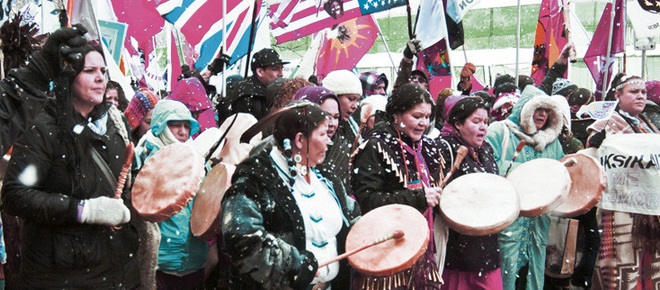First Global Meeting of the Indigenous Peoples Forum

“We, the indigenous peoples of Asia, Africa, Pacific, Latin America and the Caribbean, still conserve our diverse identities, cultures and spiritual traditions. The ecosystems within our territories are still relatively intact, and we continue to be the custodians of biodiversity. Our diverse knowledge systems and livelihood practices have the potential to contribute and inspire new models of sustainable development, building on culture and identity, firmly anchored in respect for our individual and collective rights.”
This statement emerged from the first global meeting of the Indigenous Peoples Forum, which was held on 11–12 February 2013, in Rome. This forum was established in 2011 through the International Fund for Agriculture and Development (IFAD) and included 32 participants from 27 different countries who came together “pledging to protect, respect and promote self-driven development to ensure that rural and agricultural growth is synonymous with the preservation of indigenous culture and identity.”
The objectives of this forum included to monitor and evaluate the implementation of IFAD Policy of Engagement with Indigenous Peoples, build partnerships between IFAD and indigenous peoples to address issues of poverty and sustainable development, and the promote the participation of Indigenous peoples in IFAD activities at country, regional and international levels and all stages of project planning and implementation.
The recommendations from this forum include a call for governments, IFAD and indigenous persons to work jointly toward developing sustainable development and best practices; for governments of recognize indigenous rights to lands and resources, and build the capacity of government toward indigenous rights with emphasis on fulfilling the UN Declaration on the Rights of Indigenous Peoples, and acknowledging the role of indigenous traditional institutions, authorities and organizations.
This forum differs from other similar bodies at the international level, such as the UN Permanent Forum on Indigenous Issues, in that it is open to civil society at large, rather than a group of “experts.” This forum seems to take a more grassroots approach in structuring the goals and objectives of the forum and creates a different platform for cross-cultural dialogue between various indigenous groups.
As the first meeting for this new forum, the persons in attendance were able to push forward a concrete agenda and a plan for greater cooperation and coordination among governments, communities, and international organizations/bodies. This forum has a great start and has the potential to move forward with important changes. However, the challenge now is to maintain coordination and momentum, and continue to reach out to more indigenous groups by taking action on these outputs, rather than remaining yet another toothless declaration created at an international forum.
On 16 November 2010, the Third Committee of the General Assembly adopted a resolution on indigenous peoples` issues, deciding to organize a World Conference on Indigenous Peoples in 2014 as a High-level Plenary meeting of the General Assembly. This conference will culminate the Second International Decade of the World’s Indigenous Peoples. It is likely to take place in New York, but its date has not yet been finalized.
Photo: Participants at the Global Indigenous Women`s Caucus (GIWC) preparatory meeting (27–28 March 2013) for the high level plenary meeting to be called the World Conference on Indigenous Peoples 2014. The preparatory meeting was held in the traditional territories of Haudenosaunee Confederacy, at American Indian Community House.
|